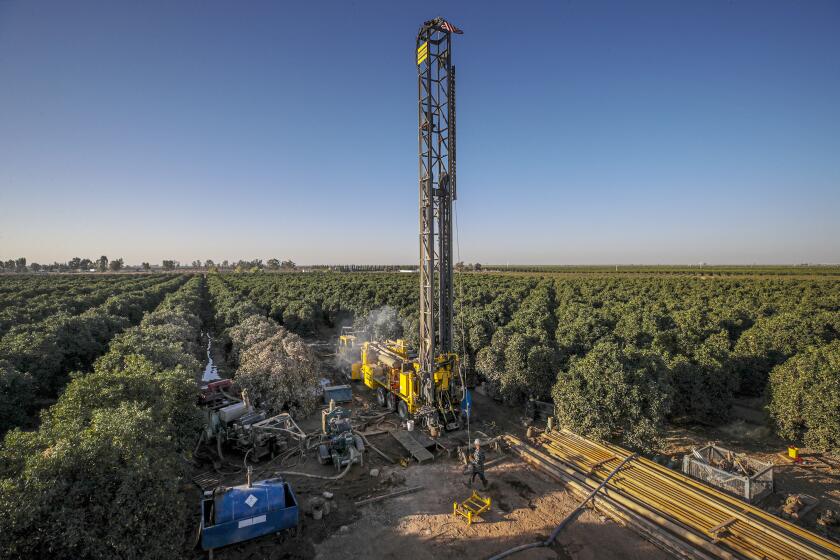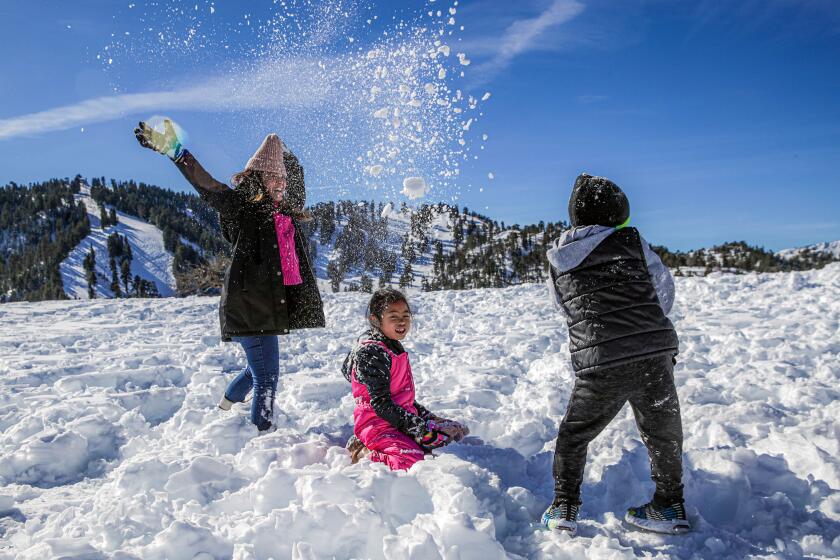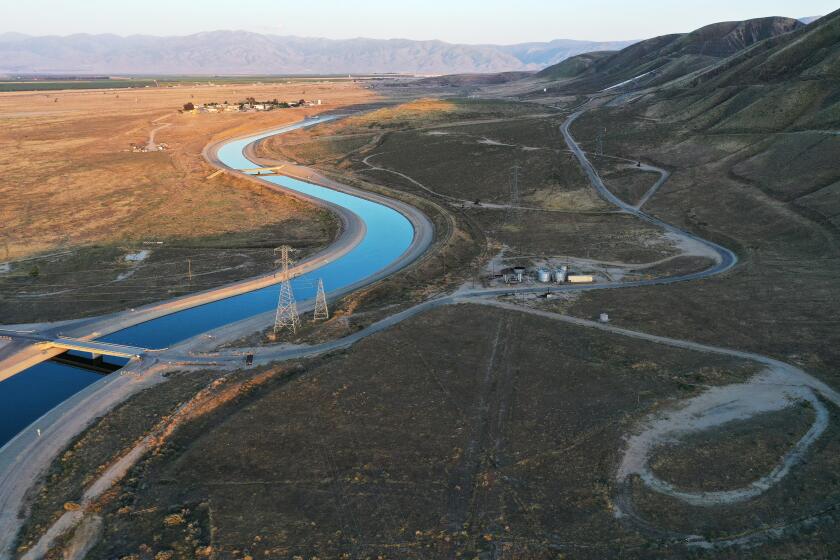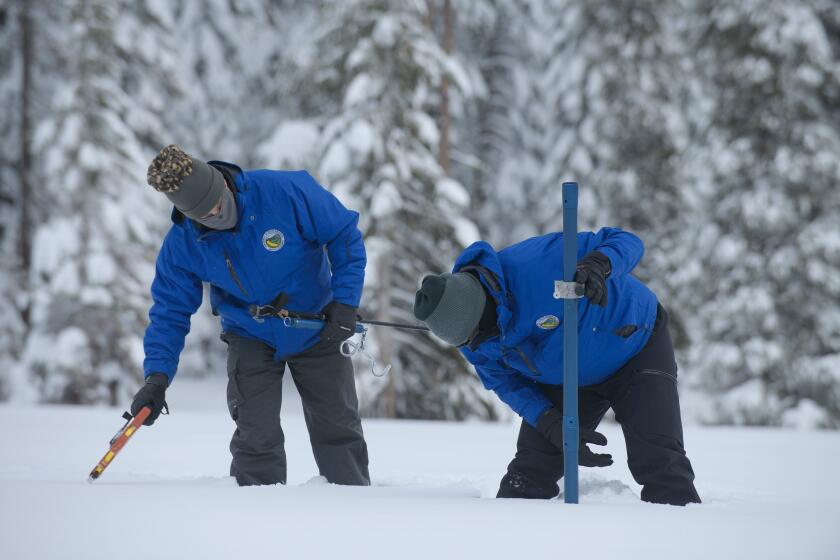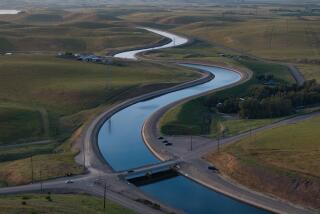December storms allow for ‘modest increase’ in state water deliveries
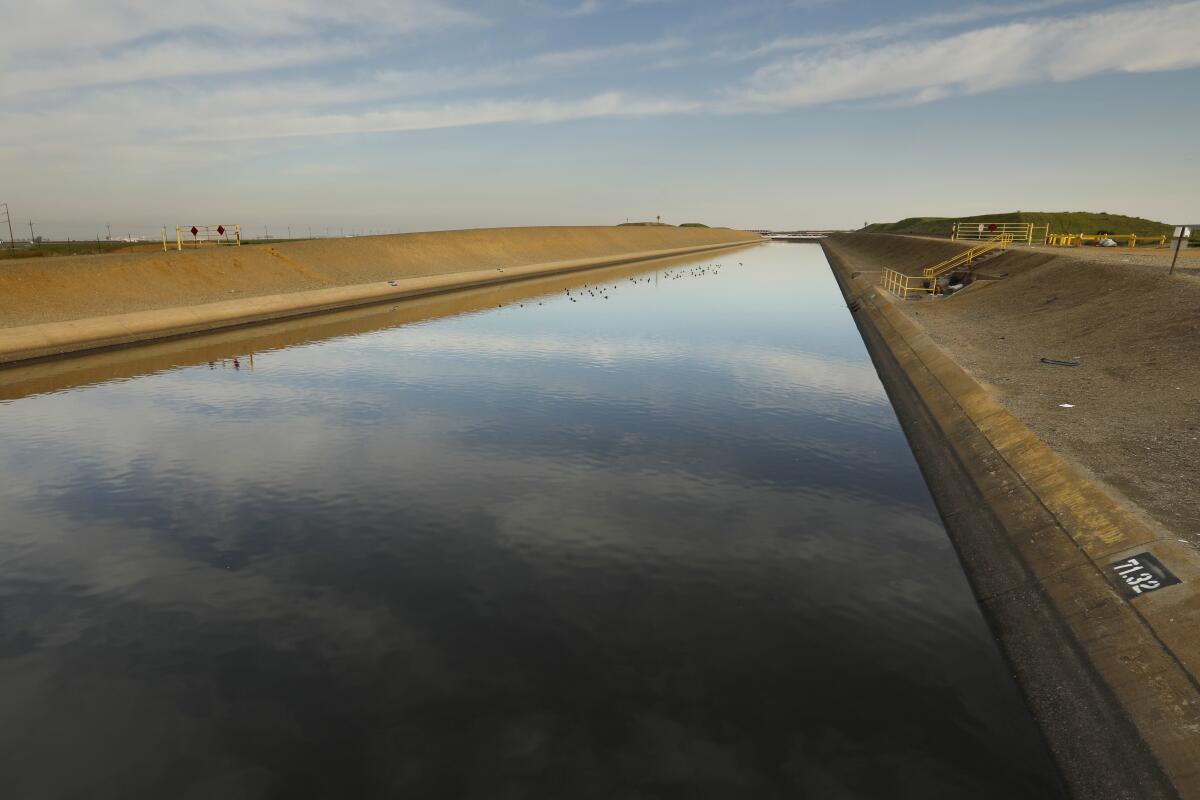
Nearly two months after extreme drought conditions forced the state to eliminate water allocations along the massive State Water Project, regulators have announced a modest increase in deliveries due a recent series of drenching storms.
December’s surprising but welcome surge of record-breaking rain and snow — including more than 17 feet of powder at Donner Pass — provided enough moisture to boost planned allocations from 0% to 15%, the Department of Water Resources said Thursday.
“December storms enabled [the Department of Water Resources] to convey and store water in San Luis Reservoir, which allows for a modest increase in water deliveries this year,” the agency’s director, Karla Nemeth, said in a statement.
At the start of December, officials said the drought had shrunk the region’s reservoirs to such historic lows that they could only allocate enough water to cover critical health and safety needs of the 29 water agencies that receive supplies from the State Water Project, a complex systems of reservoirs, canals and dams. Those agencies together provide water for about 27 million residents.
Though 15% is far from a deluge, the news marks a welcome shift for a state that has endured two years of fallowed fields, barely trickling streams and tightening water restrictions. The 2021 water year, which ended Sept. 30, was the California’s driest in a century.
Despite a California law intended to end over-pumping of aquifers, a frenzy of agricultural well drilling continues in the San Joaquin Valley.
Critically, the allocation increase does not mean the drought is over, Nemeth said. The state needs more storms to continue to make up for the deficits of so many critically dry years.
“Dry conditions have already returned in January,” she said. “Californians must continue to conserve as the state plans for a third dry year.”
Indeed, the year is already off to an arid start, and the U.S. Drought Monitor map still shows most of California under moderate and severe drought conditions.
Scott Rowe, a meteorologist with the National Weather Service in Sacramento, said many parts of the state have received only 20% or less of normal precipitation compared with typical January values.
“By far, it’s been a drier month compared to December, and even also compared to October when we had that big atmospheric river,” he said.
In the Central Sierra, statewide snowpack on Friday was still hovering at a healthy 109% above normal for the date, but the number had fallen from 139% from just two weeks prior as some of the December snow is already starting to melt.
The recent rains did not completely eliminate the drought, but they certainly helped improve drought conditions, water experts say.
As a result of December’s rain and snow, the Department of Water Resources and the U.S. Bureau of Reclamation were also able to withdraw their application for a temporary petition that would have enabled them to release less water into the Sacramento-San Joaquin Delta through April.
The delta is the state’s hydrological hub, and the petition had been intended to conserve limited stored water in the Shasta, Oroville and Folsom reservoirs.
While Shasta remains in critical condition, the Oroville and Folsom reservoirs are in better shape, officials said.
Oroville — the state’s largest reservoir — on Friday was at 45% capacity, compared with 30% at the start of December, according to state data. Earlier this month, officials were able to bring Oroville’s hydroelectric power plant back online after the drought forced its closure for the first time ever last August.
The Department of Water Resources will continue to prioritize releases from the reservoir to “maintain delta water quality, protect endangered species and meet senior water right needs,” officials said, and to preserve as much storage as possible.
The resolution calls on residents to step up conservation efforts, but focuses especially on six water agencies that rely on the State Water Project.
The allocation increase should also keep most water districts from having to implement the most severe cutbacks, including the Metropolitan Water District in Southern California, the state’s largest customer.
The agency, which supplies water to about 19 million people across six counties, receives about a third of its supply from the state, with the rest coming from the Colorado River and other sources like local stormwater, groundwater and recycling and desalination.
“The snow and rain we received in December provided some much-needed relief to the extremely dry conditions challenging our state,” said Adel Hagekhalil, the agency’s general manager.
But, he added, “15% allocation is still very low, and our water supplies from the State Water Project remain exceptionally limited.”
“Even with this modest allocation, we’ll need to continue drawing down our storage reserves to meet demands,” Hagekhalil said. “To make those reserves last if the dry conditions prevail into next year, we all need to keep using water as efficiently as possible.”
The agency in November declared a drought emergency in Southern California, following a similar statewide declaration from Gov. Gavin Newsom in October. Neither declaration has been lifted, and the governor is still asking residents to voluntarily reduce their water usage by 15%.
Storms in December pushed California snowpack to 160% of average, giving a boost to the state’s drought-depleted water supplies.
Many experts say the recent dry years have offered some hard lessons for California, which is likely to keep getting drier and hotter due to the effects of climate change.
Even after December‘s precipitation, officials at the State Water Resources Control Board adopted regulations that outlaw water wasting — a powerful indication that drought conditions persist and that conservation efforts should continue.
“We are not out of the woods yet,” Chief Deputy Director Eric Oppenheimer said at the time.
Hagekhalil emphasized that the state needs “bold and strategic investments” in water storage, conveyance and conservation, as well as direct federal and state support to help communities better prepare for future droughts and climate change.
For its part, the Department of Water Resources said officials are continuing to plan for “climate uncertainty” by implementing technologies to improve forecasting and monitoring capabilities, among other efforts.
The annual State Water Project allocation — which is initially announced Dec. 1 each year — is continually updated through the winter months, the department said. The final allocation will be determined in May or June.
More to Read
Sign up for Essential California
The most important California stories and recommendations in your inbox every morning.
You may occasionally receive promotional content from the Los Angeles Times.
